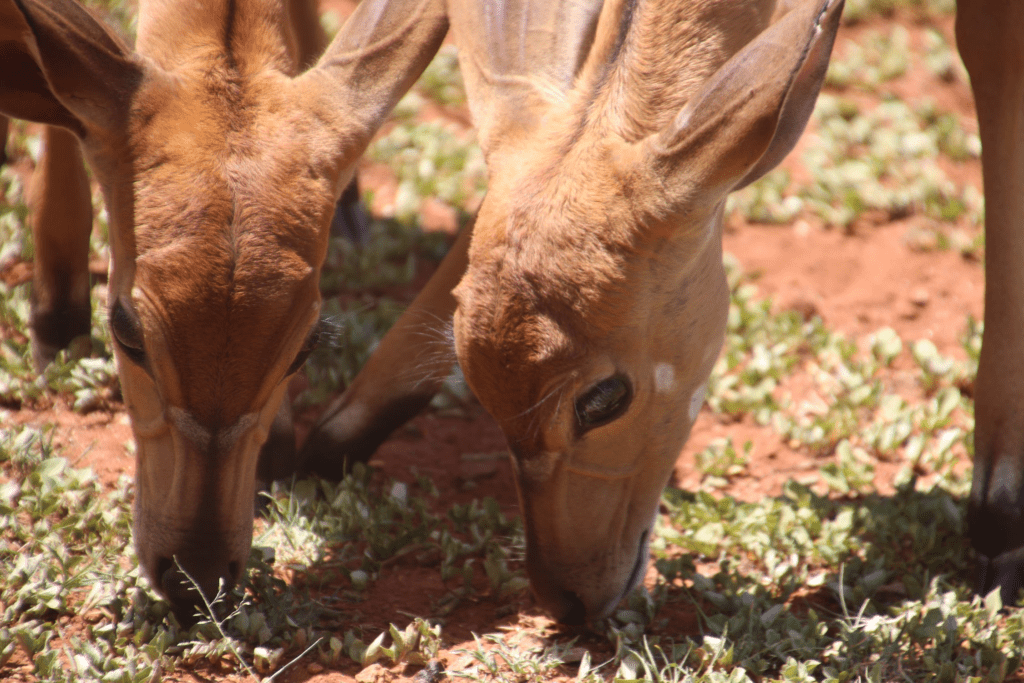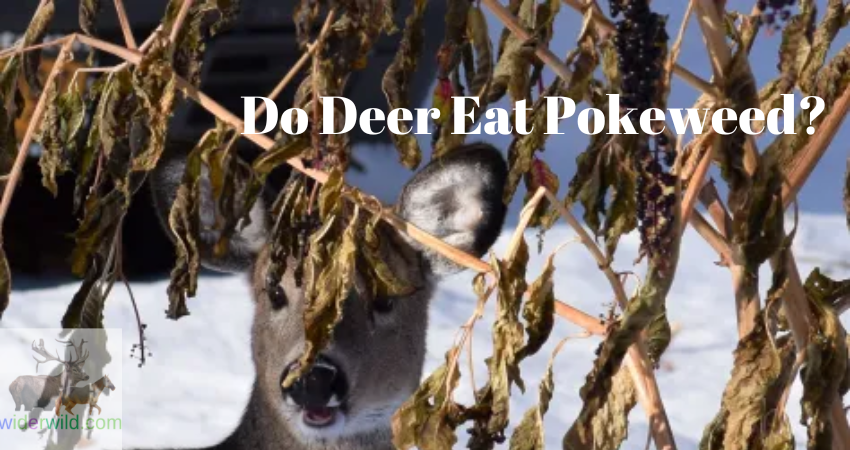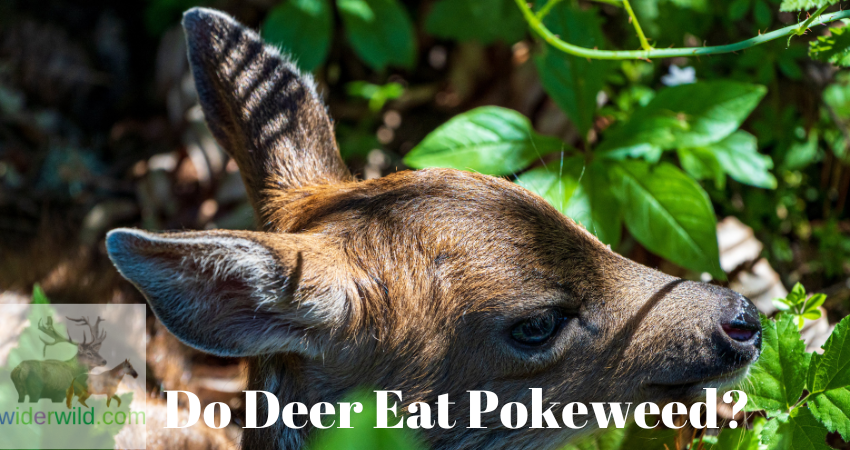Yes, deer do eat pokeweed. Pokeweed is a part of the deer’s natural diet, and they often consume its leaves and berries.
However, caution should be exercised as pokeweed can be toxic to humans and pets. Deer are known for their varied and adaptable diet, which consists of grasses, leaves, berries, and even tree bark. One particular plant that falls into their menu is pokeweed.
Found in many parts of North America, pokeweed (Phytolacca americana) is a tall, perennial herbaceous plant that produces clusters of dark purple berries.
While it may seem surprising that deer would consume a plant with toxic properties, they have evolved to tolerate and even thrive on various vegetation, including pokeweed.
I delve into the details of deer’s interaction with pokeweed, explore the reasons behind their consumption, and discuss the potential risks associated with this toxic plant.
The Pokeweed Plant: An Introduction

Pokeweed, a unique plant known for its bright berries and large leaves, often raises questions about its tastiness to deer. While deer typically avoid consuming pokeweed due to its toxic nature, occasional reports indicate that they may nibble on it in times of scarcity.
Nevertheless, caution should be exercised when dealing with pokeweed, as it can cause harm to both humans and animals if ingested.
Description Of The Pokeweed Plant
The pokeweed plant, scientifically known as Phytolacca americana, is a perennial herbaceous plant that belongs to the pokeweed family, Phytolaccaceae. This native plant of
North America is recognized by its tall stature, growing up to 10 feet (3 meters) in height. The pokeweed plant has an upright branching structure with smooth, reddish-purple stems and large, elliptical-shaped leaves.
Its distinctive reddish stems and branches give it an eye-catching appearance, making it easily recognizable in its natural habitats.
Where Can Pokeweed Be Found?
Pokeweed can be found in a wide range of habitats across North America. It thrives in a variety of soil types, from moist to dry, and is commonly spotted in fields, meadows, woodland edges, and disturbed areas such as roadsides and fence lines.
While pokeweed favors full sunlight, it can tolerate partial shade, often growing near forest edges or in open clearings. This adaptable plant has a wide distribution and can be found from the eastern United States to the central part of the country, including parts of Canada.
Why Is Pokeweed Considered A Weed?
Pokeweed is often labeled as a weed due to its ability to grow vigorously and compete with other plants for resources. It has a reputation for colonizing agricultural fields and interfering with crop production.
Furthermore, its fast growth rate allows it to outcompete native flora in certain ecosystems, potentially disrupting the natural balance of plant diversity.
While pokeweed has historical and cultural significance, especially in herbal medicine, it is crucial to manage its spread to ensure the preservation of native habitats and agricultural yields.
Overview Of The Nutritional Composition Of Pokeweed

Pokeweed boasts an array of beneficial compounds. Despite being considered toxic if not properly prepared, pokeweed has been used traditionally for its medicinal properties by Native Americans.
Some of the constituents found within pokeweed include alkaloids, flavonoids, proteins, and vitamins. Additionally, it contains notable amounts of minerals such as calcium, magnesium, potassium, and iron, making it a potential source of nutrition.
Deer Diet: Understanding The Feeding Habits Of Deer
Understanding the feeding habits of deer is crucial in managing their diet. One common question is whether deer eat pokeweed. Let’s explore this topic and discover if pokeweed is part of a deer’s diet.
What Do Deer Typically Eat?
Deer are herbivores and their diet primarily consists of vegetation. However, it is important to understand what specific types of plants they prefer.
Deer typically eat a variety of grasses, leaves, twigs, berries, and nuts. Some common plant species that are part of their diet include:
- Acorns
- Clover
- Grasses
- Apples
- Blackberries
- Leaves from maple, oak, and other trees
Factors Affecting Deer’s Dietary Preferences
Several factors can influence the dietary preferences of deer:
Availability of food sources: Deer are opportunistic feeders and will consume what is easily accessible in their environment.
Seasonal changes: As the seasons change, so does the availability of food. In summer, deer may rely more on fresh grasses and leaves, while in winter, they may resort to browsing on twigs and bark when food sources are scarce.
Geographic location: Different regions may have different plant species, and this can impact the selection of food sources for deer.
Competition with other wildlife: Deer may have to adapt their feeding habits based on competition from other animals, such as rabbits or squirrels.
The Importance Of A Diverse Diet For Deer
Deer, like all living creatures, require a diverse diet for their overall health and well-being. A varied diet ensures they receive the necessary nutrients, vitamins, and minerals they need to thrive.
By consuming different types of plants, deer can balance their nutritional intake and strengthen their immune system. A diverse diet also minimizes the risk of overgrazing and helps to maintain a healthy ecosystem.
The Impact Of Seasonal Changes On Deer’s Diet
As the seasons change, the diet of deer can vary significantly. Spring and summer offer an abundance of fresh vegetation, including grasses, young shoots, and tender leaves. During these seasons, deer may focus on grazing in open fields and meadows.
In contrast, autumn and winter bring scarcity of food, especially in colder regions. During these times, deer may resort to browsing on twigs, shrubs, and the inner bark of trees. Adapting to different food sources allows deer to survive and thrive throughout the year.
Do Deer Eat Pokeweed?
Yes, deer do eat pokeweed, as it is considered a palatable food source for them. Keep in mind that while deer may eat pokeweed, it should be offered in moderation to prevent any potential negative effects on their health.
Common Misconceptions About Deer And Pokeweed
There are several common misconceptions regarding the relationship between deer and pokeweed. One of the most prevalent misconceptions is that deer avoid consuming pokeweed altogether.
This belief stems from the poisonous nature of the pokeweed plant, which contains toxins that are harmful to many animals, including humans. While pokeweed can be toxic, deer have been observed munching on its leaves despite the risks.
Evidence Of Deer Consuming Pokeweed
There is substantial evidence to support the fact that deer do consume pokeweed as part of their diet. Numerous studies conducted by wildlife experts and researchers have documented instances of deer actively feeding on pokeweed plants.
These studies have involved observing deer browsing on pokeweed leaves, stems, and berries, confirming that deer indeed eat pokeweed despite its toxicity.
Factors That May Influence Deer’s Consumption Of Pokeweed
Several factors can influence a deer’s consumption of pokeweed. Food availability is one such factor; when other food sources are scarce, deer may be more likely to turn to pokeweed as a potential food source.
Additionally, the nutritional content of the pokeweed plants themselves may vary depending on factors such as soil quality and growing conditions.
Another factor that may influence a deer’s consumption of pokeweed is the stage of growth of the plant. Young pokeweed plants contain more toxins compared to mature plants.
Therefore, deer may exhibit a preference for consuming pokeweed at specific stages when the toxicity levels are lower, reducing the risk of adverse effects from the plant.
Occurrences Of Deer Avoiding Pokeweed
While it is true that deer have been observed consuming pokeweed, there are also instances where they may avoid it.
The reasons for deer avoiding pokeweed could be multifaceted. One possible explanation is that certain populations of deer have developed an aversion to the plant due to previous negative experiences or learned behavior.
Additionally, the availability of alternative food sources and the abundance of preferred forage can play a role in the deer’s avoidance of pokeweed.
When other highly nutritious food options are readily available, deer may prioritize those over pokeweed, especially given its toxic reputation.
Nutritional Value Of Pokeweed For Deer
Pokeweed, scientifically known as Phytolacca americana, is a herbaceous perennial plant that can be found in various regions across North America.
Apart from its vibrant purple berries and sprawling leaves, it has gained attention for its nutritional composition and how it contributes to the diet of deer.
In this section, we will explore the nutritional value of pokeweed for deer and its significance in different seasons.
Nutritional Composition Of Pokeweed
Pokeweed possesses a rich nutritional profile that it provides to deer. This plant is an excellent source of various essential nutrients, including:
| Nutrient | Amount (per 100g) |
|---|---|
| Protein | 3.4g |
| Fiber | 2.8g |
| Vitamin A | 6150 IU |
| Vitamin C | 39.2mg |
| Calcium | 47mg |
| Iron | 2.7mg |
Table 1: Nutritional composition of pokeweed per 100g
How Pokeweed Contributes To Deer’s Diet
Pokeweed plays a significant role in the diet of deer, especially during certain periods of the year.
With its protein content, deer can obtain a portion of their daily protein requirements from consuming pokeweed. Additionally, the fiber found in pokeweed aids in digestion and supports gut health for deer.
Moreover, the abundance of vitamins A and C in pokeweed contributes to the overall well-being of deer.
Vitamin A is known for supporting optimal vision and immune function, while vitamin C acts as a powerful antioxidant, protecting the deer’s cells from damage caused by free radicals.
In this way, pokeweed helps maintain the general health and vitality of deer.
Potential Benefits And Drawbacks Of Feeding On Pokeweed
Potential Benefits
- Pokeweed serves as a seasonal food source, providing deer with additional nutrients during specific times of the year when other forage may be scarce.
- The high nutritional value of pokeweed helps meet the dietary requirements of deer, supporting their growth and overall health.
- The presence of vitamins and minerals in pokeweed contributes to the deer’s immune system, improving their ability to resist diseases.
Drawbacks
- While pokeweed can provide nutritional benefits to deer, excessive consumption can have adverse effects.
- The mature leaves and berries of pokeweed contain toxins, such as phytolaccatoxin and phytolaccigenin, which can be harmful if consumed in large quantities.
- Prolonged reliance on pokeweed as a primary food source can lead to imbalanced nutrition and potential health issues for deer.
Dietary Significance Of Pokeweed During Different Seasons
Pokeweed holds varying dietary significance for deer depending on the seasons:
Spring and Summer
In the spring and summer months, fresh shoots and young leaves of pokeweed emerge, providing deer with a nutritious food source. The tender shoots are particularly palatable and contain fewer toxins, making them more suitable for deer consumption during this period.
Fall and Winter
As autumn arrives, the leaves of pokeweed may become less palatable due to a higher concentration of toxins. However, the berries produced during this time provide deer with a high-calorie food source, which assists in meeting their energy requirements during the colder months.
Understanding the nutritional value of pokeweed for deer allows us to appreciate its role in their diet. However, it’s essential to ensure that deer have access to a diverse range of forage to maintain a well-rounded and balanced diet throughout the year.
Managing Pokeweed In Deer Habitats
Deer and pokeweed in the same habitat can be problematic, as deer tend to avoid eating it due to its toxicity. Managing the growth of pokeweed is important to maintain a balanced deer habitat.
Controlling the growth of pokeweed
To effectively manage pokeweed in deer habitats, it is essential to control its growth. Pokeweed, with its rapid spreading habit, can quickly overtake an area if left unchecked.
This can lead to a scarcity of other vegetation, impacting the overall health and diversity of the ecosystem. Therefore, it is crucial to implement tactics that limit the growth of pokeweed while still providing a suitable habitat for deer.
One effective method to control pokeweed growth is through manual removal. This involves physically uprooting the plants, ensuring they are pulled out completely to prevent regrowth.
While labor-intensive, manual removal can be highly effective, especially when done during the early stages of pokeweed growth. It is recommended to wear protective gloves while handling the plant, as its berries and roots contain toxins.
Another strategy for managing the growth of pokeweed is by using herbicides. Selective herbicides can be applied directly to the plant, effectively killing it without harming other desirable vegetation.
To guarantee safety and effectiveness, it is crucial to adhere closely to the instructions given by the manufacturer of the herbicide.
Additionally, it is crucial to consider the environmental impact of using herbicides and choose those that have minimal adverse effects on the ecosystem.
Balancing the presence of pokeweed for deer and ecosystem health
While it may be necessary to limit the growth of pokeweed to maintain the overall health of the ecosystem, it is important to strike a balance that considers the needs of deer.
Pokeweed, despite being toxic to humans, can serve as a valuable food source for deer, especially during certain seasons when preferred forage may be limited.
Therefore, it is essential to carefully manage pokeweed while ensuring an adequate presence for deer to thrive.
Encouraging alternative food sources for deer
To mitigate the potential loss of pokeweed as a food source for deer, it is beneficial to encourage the growth of alternative vegetation.
Planting food plots or establishing native vegetation that deer find palatable can provide them with alternative feeding options.
This not only ensures that deer have a diverse diet but also helps maintain a balanced ecosystem by reducing the reliance on a single plant species.
Other considerations for managing pokeweed in deer habitats
In addition to controlling pokeweed growth and promoting alternative food sources, there are a few other considerations to bear in mind when managing pokeweed in deer habitats.
- Regular monitoring of pokeweed populations is essential to assess the effectiveness of management strategies and determine if any modifications are required.
- It is crucial to create and maintain a favorable habitat for natural competitors of pokeweed, such as native grasses and wildflowers, which can help suppress its growth.
- Spreading awareness among landowners, hunters, and conservationists about the importance of managing pokeweed and its impact on deer habitats can contribute significantly to successful management efforts.
Landowners can effectively manage pokeweed in deer habitats by incorporating various strategies.
These include controlling its growth, maintaining a balance for deer and ecosystem health, promoting alternative food sources, and taking into account other significant factors.
By adopting this proactive approach, landowners can safeguard the well-being of deer populations and contribute to the preservation of a diverse and flourishing ecosystem.
Frequently Asked Questions on Do Deer Eat Pokeweed?
Do Deer Eat Pokeweed?
Deer generally avoids eating pokeweed due to its toxic properties and bitter taste.
Is Pokeweed Toxic To Deer?
Yes, pokeweed contains toxic substances that can be harmful to deer if consumed in large quantities.
What Are The Dangers Of Deer Eating Pokeweed?
Eating pokeweed can cause digestive issues, weakness, and even death in deer due to its toxicity.
Why Do Some People Think Deer Eat Pokeweed?
There may be misconceptions that deer eat pokeweed because they occasionally nibble on it, but it is not a preferred food source.
Can Deer Get Sick From Eating Pokeweed?
Yes, if deer consume a significant amount of pokeweed, it can lead to illness and potentially fatal consequences.
Are There Any Health Benefits For Deer In Eating Pokeweed?
No, pokeweed does not provide any significant health benefits to deer. It can be harmful to their well-being.
What Are The Alternatives To Pokeweed For Deer To Eat?
Deer have a wide variety of natural food sources, including grass, herbs, leaves, fruits, acorns, and browse from trees, which are healthier alternatives to pokeweed.
Final Words
Deer do eat pokeweed and it is a part of their natural diet. While pokeweed can be harmful to humans and livestock, it does not have the same effect on deer. However, it is important to remember that a healthy and diverse diet is crucial for deer, and they should not rely solely on one type of plant for nutrition.
Related Post On Deer Diet and Feeding:

